Waterfront Strike of 1934

SAN FRANCISCO GENERAL STRIKE (1934)
What began as an isolated longshoremen's dispute developed in the spring and summer of 1934 into one of the most sweeping and violent industrial conflicts of the Great Depression. Over the course of eighty-two days, San Francisco's waterfront workers protested their mistreatment by ship owners. Employers organized as well, resulting in a bloody confrontation and a stalemate that brought a polarized San Francisco to standstill.
The roots of the general strike lay in the harsh working lives of San Francisco's longshoremen. Each morning, under what was called the "shapeup," workers lined up at the docks as private contractors chose whom they would employ that day, forcing men to beg for work and pay kickbacks to hiring agents. Represented only by an employer-controlled company union, longshoremen had few alternatives. With the passage of the National Industrial Recovery Act of 1933, and its promise of greater cooperation with unions, however, longshoremen started to organize. Workers formed Local 38-79 of the International Longshoremen's Association (ILA), a conservative union affiliated with the American Federation of Labor (AFL), and issued a set of demands: recognition, a six-hour workday, a thirty-hour workweek, and a pay increase. A radical faction of longshoremen led by Australian-born Harry Bridges raised the stakes further by demanding that the shape-up be replaced by a union hiring hall. When ILA officials negotiated an agreement that left out the hiring hall, rank-and-file members of Local 38-79 suspended their president.
Unable to win their broader demands, longshoremen throughout the Pacific Coast region went on strike on May 9, 1934. Workers rallied together in unprecedented solidarity, virtually closing down all West Coast ports. Responding to their members' pleas, the Teamsters and the seamen's unions supported the longshoremen by refusing to service the ports. Despite pressure from union and public officials, San Francisco's longshoremen, now led by Bridges, held firm. Responding in kind, business leaders coordinated their efforts to undermine the strike through the Industrial Association of San Francisco, an alliance of industrial, banking, shipping, railroad, and utility firms that was formed in 1921. The Association, with the help of a public relations firm, launched a campaign alleging that the strike was a Communist plot. Historians have since rejected that claim, though some strike leaders, including Bridges, were either members of or sympathetic to the Communist Party.
The violence between strikers, scabs, and police escalated on July 5, which would be remembered as "Bloody Thursday." At midday, police and vigilantes fired on strikers who had retreated for a lunch break, killing two. By the day's end, another seventy strikers had been seriously injured. Over the next two weeks, California's governor mobilized the National Guard to restore order while the National Longshoremen's Board, appointed by President Franklin Roosevelt, struggled unsuccessfully to restart negotiations between strikers and employers. On July 16, sixty-three unions of the San Francisco Labor Council commenced a general strike that involved 130,000 workers, shut down the city, and took over basic services, such as the distribution of food. The Industrial Association of San Francisco, the mayor, and a consortium of the city's newspapers reacted with a hyperbolic campaign that depicted the general strike as a Communist insurrection. Although the campaign did not achieve its objective—a military crackdown by Roosevelt—the accusation of treason scared the more cautious labor leaders, who terminated the general strike after only three days. On July 30 the ILA membership overwhelmingly agreed to end their strike and to accept binding arbitration by the National Longshoremen's Board. The Board granted the ILA a collective bargaining agreement, a hiring hall virtually controlled by the union, and a significant pay increase.
The longshoremen and general strikes demonstrated the power and quickness with which ordinary workers could act if pushed too far. The latent radicalism and solidarity of the rank-and-file served as both a warning to employers, who slowly became receptive to mediated settlements, and a promise to aggressive labor leaders, who soon left the conservative AFL and formed the Congress of Industrial Organizations (CIO) to unionize workers across job categories. The strikes also demonstrated the impact of federal labor policy: The National Industrial Recovery Act and the federal labor board were vital to both the instigation and resolution of the conflict. Most of all, the general strike represented the fraying of social bonds that could only get worse if the economic crisis of the Depression continued.

Oakland Tribune - Sat - Jul. 14, 1934
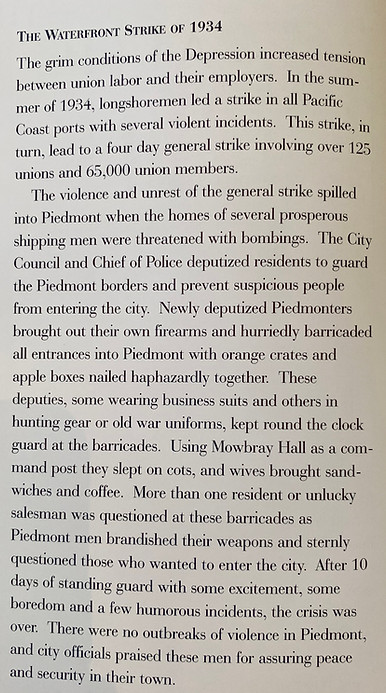
Piedmont Historical Society's publication says there were no outbreaks of violence.

Discrepancies in the stories - The Piedmont Historical Society, the Queen of the Hills book vs the news.
The Piedmont Historical Society, formed in 1971, tends to use a lot of the "facts" from the the book, the Queen of the hills written in 1953. Both sources say no one was hurt during this, nevertheless, the news clipping above and repeated in many other states said "strikers sent four men to Piedmont's only barber shop and ordered it closed. A patron notified the police. The four were treated with night sticks and jailed. A clean-up squad of four more strikers came in. They were treated likewise." While this isn't as much violence as other areas experienced it is another example of how the facts are not always correct from the HS or the Queen's book.
Queen of the Hills said for ten days several homes of "big shipping men" who were living in Piedmont were threatened with bombing. Brave fathers and husbands were apparently sworn in as "Special Officers" while headquarters was set at Mowbray Hall. At all protected entrances of the city any person that came through via foot, bike or motor, one of the many civilian guards would caress their guns. The Queen of the Hills book mentions only that three laundrymen tried to deliver packages and when they tried to exit they were led by the "regular police" led the laundrymen to jail and charged them with disturbing the peace. The author also incorrectly says the Police Chief was Pflaum while the Chief was actually Heere and Pflaum was the Captain.

Oakland moving and storage : entrepreneur, Rotarian, and philanthropist: oral history transcript / 1973 by Lyon, Harvey Blanchard, Bancroft Library. Regional Oral History Office:
The Waterfront Strike of 1934 Defense of Piedmont
RL: You were going to tell me today about the strike in Piedmont, and what you did. What year was that?
Lyon: 1934. It was a thrilling experience for me. You know of my sort of boyish interest in what is happening, and this was a thrill to get an invitation to come and take charge of the police of Piedmont for about a week during the strike that occurred in 1934.
RL: Who was striking at the time?
Lyon: Those striking were the longshoremen on the water front in San Francisco and they came over into Piedmont where the Standard Oil stations were. There were two big Standard Oil stations in Piedmont, one up in what is now the center of Piedmont, and the other down where Piedmont touches Oakland. That reminds me of a restaurant man who lived in Piedmont --when he came to go home at night he found he was prohibited from entering his own community. He wrote me a letter later: "Dear Mr. Lyon, I an so grateful to you for keeping me out of my home because I knew you were doing it for my safety. I went back to my restaurant in Oakland just over the line, and I slept on one of my tables knowing my family was okay. "
Wallace Alexander was the man who invited me, calling down to Pleasanton where I was staying with a friend. He not only invited me, but when anyone around Piedmont said, "Wallace Alexander wants you," you answered, because Mr. Wallace Alexander was a prince of a man we all thought and think.
Oscar Sutro, of the big Sutro family in San Francisco helped too. He had a home at the head of Oakland Avenue in Piedmont. He had a chauffeur and went around to the thirty-two entrances from Oakland into Piedmont supplying hot coffee to those who were staying awake all night to guard the entrances. Where they didn't have enough guns they got pick handles. The city bought pick handles right away for their use.
RL: What was the threat? What were people afraid of in Piedmont?
Lyon: Who was the biggest man on the waterfront in San Francisco? Harry Bridges. He was directing what he thought was a smart thing to get the union men whatever they wanted to ask for. They thought that with all the monied and very highly respected people In Piedmont if they would work through them they could get what they wanted. But they were mistaken.
Lyon: In about four or five days of the strike keeping everything shut off nobody could buy any gasoline in Piedmont or the waterfront in San Francisco the authorities decided it was time to get busy. They then asked me to help break the strike. Because I was a young fellow and they thought aggressive, and enjoyed perhaps a little activity. I had the backing of the Standard Oil Company and Wallace Alexander and the police.
I entered the Job with real enthusiasm. We went out to Emeryville where a Standard Oil truck was standing, pointed towards Piedmont Just waiting for the bodyguard to come from Piedmont, outriders on motorcycles. I had instructions from the police chief of Piedmont to keep my eyes on the windows as we drove by, because that's where they had learned the people who were trying to make trouble sat with their rifles ready to work.
RL: Why did people feel they needed so much police protection?
Lyon: Because so much depended on the people who lived in Piedmont. Mr. Dollar had a big home there, Sammy Dollar, and, as I mentioned, Wallace Alexander, and Dr. Gerbode and his wife. Mrs. Gerbode has since passed away as you may have heard. They were such important people. The only thing I had to bother about was to get my gun back. I had a very fine shotgun for hunting. Somebody thought well of it too. I was about six weeks tracing it through the police.
Reno Gazette Journal - Fri - Jul. 20, 1934
The big strike by Quin, Mike, 1906-1947, Publication date [1949]
Hundreds of persons put on roller skates and solved their transportation problem by turning the streets into giant rinks.
Across the bay in Piedmont, an exclusive residential city devoted to wealthy homes, businessmen armed themselves and placed the locality in a state of siege. Two hundred and fifty of them were sworn in as special deputies. Clad in golf knickers and hunting jackets, and flourishing revolvers, shotguns, and rifles, they blocked the entrances to all streets, stopping automobiles and persons for examination.
News article from probably the Piedmonter (from PPD archives):
Piedmont Guards Are Well Fed
In order to serve the perspiring home guards during the silent watches of the night, an emergency food committee was formed to distribute coffee and sandwiches twice during the nocturnal sojourn.
In the first days of the siege many of the vigilantes stood guard 11 and 12 hours at a stretch, acquiring a good growth of beard on previously suavely-shaved jowl to prove it. Later, however, a series of shifts was worked out so that no one need stand guard more than six
hours.
News article from probably the Piedmonter (from PPD archives):
Four Arrested on Intimidation Charge
Alex Allen and Philip A. Hershey, citizens of Piedmont, heard that a barber shop in Highland Avenue had been threatened, and without
waiting for the police, they caught the men who did the threatening, and arrested them. F. Butler, J. Dolan, Louis Perry, and G. B. Knight, strike sympathizers, were arraigned before Judge F. 0. Nebeker, pleaded not guilty of disturbing the peace, and were released on $1000 bail. Their trial will come up Friday morning.
Allen and Hershey are two of the members of the Piedmont Citizens' Committee which is guarding all roads to Piedmont, to keep marauders out of the city.
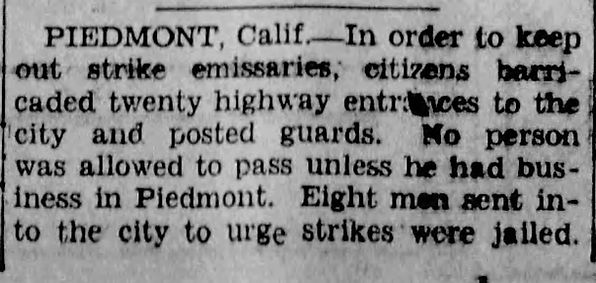

The Cushing Daily Citizen -
Sun - Aug. 5, 1934
Los Angeles Evening Post Record - Wed - Jul. 18, 1934
Piedmonter - July, 20 1934:
Special Police Piedmont During (Waterfront Strike)
Armed special police patrolling the streets and guarding all entrances to the
city assured Piedmont residents of a plentiful supply of gasoline and other necessities during the emergency period as well as guaranteed safety of property.
The force, estimated at three hundred, was composed of citizen volunteers identified with yellow arm-bands marked with the black letters "S. P."-which did not stand for Social Problems club. The vigilantes were armed to the teeth with shot-guns, pick handles and pistols. Many brought guns and equipment used in the World war. One had a German Luger automatic equipped with a removable stock. Another carried a six-shooter nearly two feet long in an embossed and fringed leather holster. Many were in duck hunting togs and carried shot-guns. Those who had fire-arms equipped at the expense of the city with stout oak pick-handles. Several boxes of the handles were brought in to be distributed to the guards.
Costumes were as varied as weapons. Some were in business suits while others made a holiday and dressed in the clothes usually reserved for vacation excursions, fishing and hunting. Many wore olive-drab left from the Great war. One boy motorcyclist wore a pair of heavy fur arctic gloves fastened on thongs around his neck.
A considerable crowd was gathered early in the morning waiting to be posted
for duty. Members of relieved posts filtering in to report off were challenged
by sentries heavily armed. Now and then an officer would call off names of a relieving garrison who would arm themselves and drive to their posts. A convoy of eight cars was made up to escort a truck of gasoline but was disbanded when the company reported that they had all the fuel necessary. Gradually the group thinned out, those not immediately assigned to duty going to the Masonic hall to sleep or play bridge.
Several deplored the scarcity of communists, opining that they had all been fished out by the National guard.
Despite the exceedingly martial array reminiscent of Vigilante days in early
California, there was very little excitement. According to Police Captain William Pflaum there were no arrests made and few turned back. Piedmont was quiet as usual. Pflaum said the vigilantes would maintained until the strike was defily over.
News article from probably the Piedmonter (from PPD archives):
In Piedmont the local committee set up barricades on all the streets leading into the city, and armed guards were posted at these to stop and question every person, whether in an automobile or on foot, who attempted to cross the municipal line.
Those whose purpose appeared to be legitimate were allowed to pass, while all others were turned back. The work of patrolling and guarding in Piedmont, even last night, was in the hands of 414 volunteer citizens who were appointed as special police officers by Chief of Police Fred Heere.
Among them were young college graduates, unemployed men, professional men, and others, and
they were all armed. (Article's bold)
"Their arms range from pick handles to shotguns,” said Heere. "But every one of them has a weapon of some kind.”
At some of the barricades there were from seven to ten guards, while at those on the less frequently used streets there were only
two or three.



The Plain Speaker - Fri - Jul. 20, 193
(Hazleton, Pennsylvania)
Fear of Gas Shortages

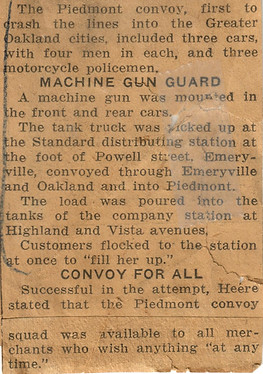
Fear of Communists
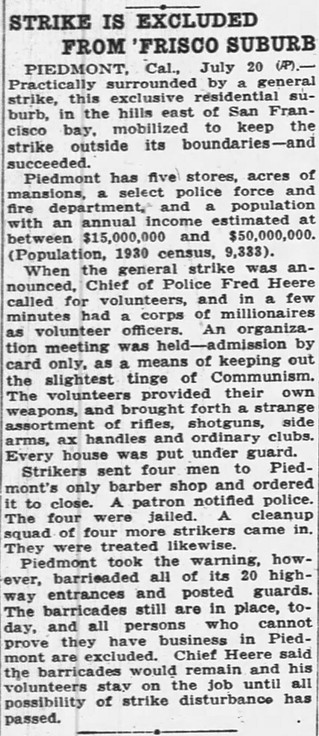
The York Dispatch - Fri - Jul. 20, 1934
(York, Pennsylvania)
"An organization meeting was held -- admissions by card only, as a means of keeping out the slightest tinge of Communism."

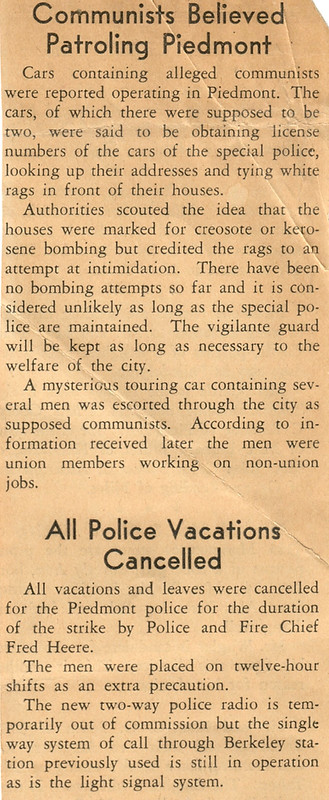

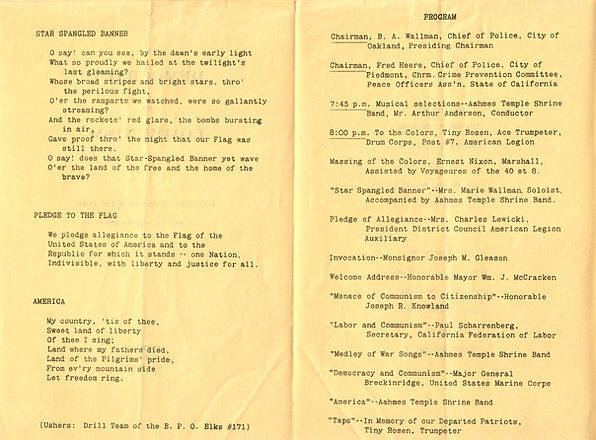
The next year Chief of Piedmont Police, Fred Heere, attended a Democracy vs Communism meeting in Oakland
